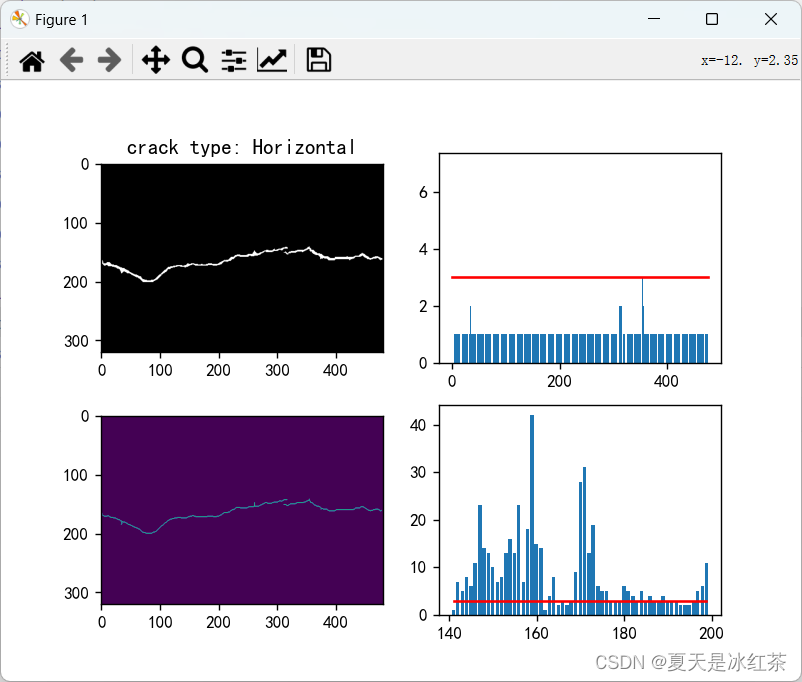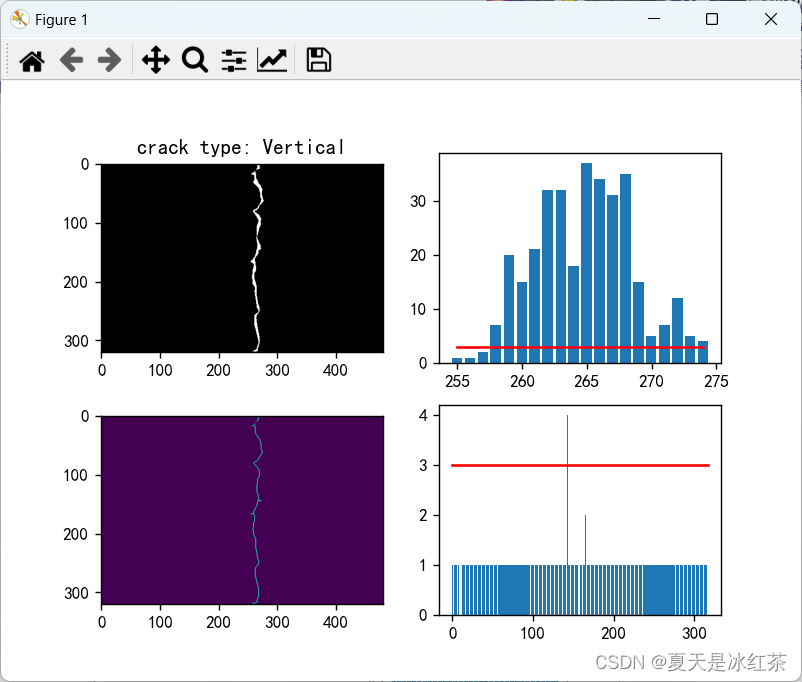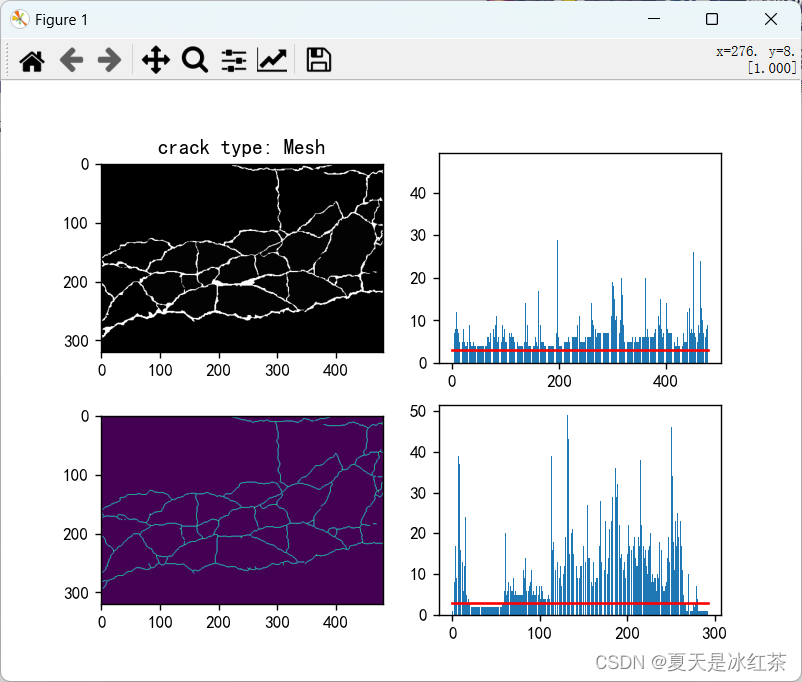裂缝类型选择
裂缝类型有很多种,这里我们判断类型的目的是要搞明白是否有必要检测裂缝的长度。在本文中,需要判断的裂缝类型共有四种:横向裂缝、纵向裂缝、斜裂缝、网状裂缝。
环境搭建
上一节骨架图提取部分,我们已经安装了skimage,并且在这里最好还是要有torch环境。接下来,如果你已经有的就没必要下了。
opencv-python:
pip install opencv-python -i https://pypi.tuna.tsinghua.edu.cn/simpleopencv-contrib-python:
pip install opencv-contrib-python -i https://pypi.tuna.tsinghua.edu.cn/simplematplotlib:
pip install -i https://pypi.tuna.tsinghua.edu.cn/simple matplotlib==3.5.2pyzjr:
pip install pyzjr -i https://pypi.tuna.tsinghua.edu.cn/simple最好按照顺序来,因为pyzjr需要的依赖比较的多。
裂缝类型判断
获取图片文件
首先,我们肯定要有目标文件夹和结果保存文件夹。从文件夹中读取下面的图片路径,这里有一个bug,具体可以看这里。
masks_dir = r"E:\pythonconda2\dimension2_data\num"
results_save_dir = "A_results"
os.makedirs(results_save_dir, exist_ok=True)
imgfile = pz.getPhotopath(masks_dir)在我们的imgfile里面就储存了该文件夹下图片的路径。
获取最小外接矩形信息
接下来,get_minAreaRect_information函数会从二值化掩膜图像中提取最小外接矩形的相关信息,包括中心点坐标、宽高和旋转角度。inference_minAreaRect函数用于计算最小外接矩形框的宽、高和角度信息,并将角度转换为相对于图像水平方向的夹角。
def inference_minAreaRect(minAreaRect):
w, h = minAreaRect[1]
if w > h:
angle = int(minAreaRect[2])
else:
angle = -(90 - int(minAreaRect[2]))
return w, h, angle
def get_minAreaRect_information(mask):
mask = pz.BinaryImg(mask)
contours, hierarchy = cv2.findContours(mask, cv2.RETR_EXTERNAL, cv2.CHAIN_APPROX_SIMPLE)
contour_merge = np.vstack(contours)
minAreaRect = cv2.minAreaRect(contour_merge)
return minAreaRectpz.BinaryImg获取图像二值图,请确保读取时候为BGR的图片。
初始化分类裂缝的参数
创建了一个ClassificationCrack类,并且对裂缝的分类参数进行初始化,有分类裂缝的阈值threshold,分类裂缝的高宽比阈值HWration,用于分类裂缝的直方图比例阈值Histration。
class ClassificationCrack():
def __init__(self,threshold=3,HWratio=10,Histratio=0.5):
self.threshold=threshold
self.HWratio=HWratio
self.Histratio=Histratio
self.types = {0: 'Horizontal',
1: 'Vertical',
2: 'Oblique',
3: 'Mesh'}这里我们使用字典self.types,这样就可以通过键值对判断裂缝的类型了。
骨骼点投影直方图
在ClassificationCrack类下,我们再定义了一个hist_judge的方法,less_than_T统计直方图中大于 0 且小于等于阈值 self.threshold 的像素数量,more_than_T统计直方图中大于阈值 self.threshold 的像素数量。通过more_than_T / (less_than_T + 1e-5)来比较是否超过了直方图比例阈值。
def hist_judge(self, hist_v):
less_than_T = np.count_nonzero((hist_v > 0) & (hist_v <= self.threshold))
more_than_T = np.count_nonzero(hist_v > self.threshold)
return more_than_T / (less_than_T + 1e-5) > self.Histratio裂缝分类
classify 方法是 ClassificationCrack 类中的另一个成员方法,它接收三个值,minAreaRect 是一个元组,表示最小外接矩形框的信息,包括中心点坐标、宽高和旋转角度;skeleton_pts是一个数组,表示骨骼点的坐标;HW是当前 patch 的高和宽。
def classify(self, minAreaRect, skeleton_pts, HW):
H, W = HW
w, h, angle = inference_minAreaRect(minAreaRect)
if w / h < self.HWratio or h / w < self.HWratio:
pts_y, pts_x = skeleton_pts[:, 0], skeleton_pts[:, 1]
hist_x = np.histogram(pts_x, W)
hist_y = np.histogram(pts_y, H)
if self.hist_judge(hist_x[0]) and self.hist_judge(hist_y[0]):
return 3
return self.angle2cls(angle)
@staticmethod
def angle2cls(angle):
angle = abs(angle)
assert 0 <= angle <= 90, "ERROR: The angle value exceeds the limit and should be between 0 and 90 degrees!"
if angle < 35:
return 0
elif 35 <= angle <= 55:
return 2
elif angle > 55:
return 1
else:
return None利用 inference_minAreaRect 函数从 minAreaRect 中获取旋转矩形框的宽度 w、高度 h 和角度 angle。接下来,通过判断 w / h 和 h / w 是否小于 self.HWratio 来判断旋转矩形框的长宽比是否满足分类条件。
如果长宽比满足条件,则将 skeleton_pts 按照 x 和 y 方向投影到直方图 hist_x 和 hist_y,然后通过 self.hist_judge 方法判断这两个直方图是否满足分类条件。以上条件均满足,则会认为是网状裂缝,否则就使用angle2cls来进行角度分类。
根据角度的大小将裂缝分为以下三类:
- 如果角度小于 35 度,则返回 0,表示水平裂缝。
- 如果角度在 35 到 55 度之间,则返回 2,表示倾斜裂缝。
- 如果角度大于 55 度,则返回 1,表示垂直裂缝。
- 如果角度不在上述范围内,则返回 None 。
主文件
if __name__ == '__main__':
masks_dir = r"E:\pythonconda2\dimension2_data\num" # 这里改为存放上面图片的路径
results_save_dir = "A_results"
os.makedirs(results_save_dir, exist_ok=True)
classifier = ClassificationCrack()
imgfile = pz.getPhotopath(masks_dir)
for path in imgfile:
mask = cv2.imread(path)
H, W = mask.shape[:2]
mask_copy = mask.copy()
skeimage, skepoints = pz.ske_information(mask_copy)
minAreaRect=get_minAreaRect_information(mask)
timer=pz.Timer()
w, h, angle = inference_minAreaRect(minAreaRect)
print(w, h, angle)
pts_y, pts_x = skepoints[:, 0], skepoints[:, 1]
hist_x = np.histogram(pts_x, W)
hist_y = np.histogram(pts_y, H)
timer.stop()
print("time cost: ", timer.total())
result = classifier.classify(minAreaRect, skepoints, HW=(H, W))
crack_type = classifier.types[result]
print(crack_type)
T = classifier.threshold
plt.figure()
plt.subplot(221)
plt.imshow(mask_copy)
plt.title("crack type: {}".format(crack_type))
plt.subplot(222)
plt.plot(hist_x[1][:-1], [T] * len(hist_x[0]), 'r')
plt.bar(hist_x[1][:-1], hist_x[0])
plt.subplot(224)
plt.plot(hist_y[1][:-1], [T] * len(hist_y[0]), 'r')
plt.bar(hist_y[1][:-1], hist_y[0])
plt.subplot(223)
plt.imshow(skeimage)
# plt.savefig(os.path.join(results_save_dir, mask_file))
plt.show()检测的效果图:

图1 横向裂缝

图2 纵向裂缝

图3 斜裂缝

图4 网状裂缝
检测效果均不错,threshold,HWratio,Histratio这三个初始值均为经验所得,大家在用的时候还是要依照自己的数据来设定,可以看见左下的图,此图为没有经过消除毛刺的骨架图,但并不影响,我们采用的是骨骼点投影直方图的方法,些许毛刺影响不了我们的判断。
全文代码如下:
"""
裂缝分类如何判断
横向、纵向、网状、斜裂缝
"""
import os
import time
import matplotlib.pyplot as plt
import numpy as np
import cv2
import pyzjr as pz
def inference_minAreaRect(minAreaRect):
w, h = minAreaRect[1]
if w > h:
angle = int(minAreaRect[2])
else:
angle = -(90 - int(minAreaRect[2]))
return w, h, angle
class ClassificationCrack():
def __init__(self,threshold=3,HWratio=10,Histratio=0.5):
self.threshold=threshold
self.HWratio=HWratio
self.Histratio=Histratio
self.types = {0: 'Horizontal',
1: 'Vertical',
2: 'Oblique',
3: 'Mesh'}
def hist_judge(self, hist_v):
less_than_T = np.count_nonzero((hist_v > 0) & (hist_v <= self.threshold))
more_than_T = np.count_nonzero(hist_v > self.threshold)
return more_than_T / (less_than_T + 1e-5) > self.Histratio
def classify(self, minAreaRect, skeleton_pts, HW):
H, W = HW
w, h, angle = inference_minAreaRect(minAreaRect)
if w / h < self.HWratio or h / w < self.HWratio:
pts_y, pts_x = skeleton_pts[:, 0], skeleton_pts[:, 1]
hist_x = np.histogram(pts_x, W)
hist_y = np.histogram(pts_y, H)
if self.hist_judge(hist_x[0]) and self.hist_judge(hist_y[0]):
return 3
return self.angle2cls(angle)
@staticmethod
def angle2cls(angle):
angle = abs(angle)
assert 0 <= angle <= 90, "ERROR: The angle value exceeds the limit and should be between 0 and 90 degrees!"
if angle < 35:
return 0
elif 35 <= angle <= 55:
return 2
elif angle > 55:
return 1
else:
return None
def get_minAreaRect_information(mask):
mask = pz.BinaryImg(mask)
contours, hierarchy = cv2.findContours(mask, cv2.RETR_EXTERNAL, cv2.CHAIN_APPROX_SIMPLE)
contour_merge = np.vstack(contours)
minAreaRect = cv2.minAreaRect(contour_merge)
return minAreaRect
if __name__ == '__main__':
masks_dir = r"E:\pythonconda2\dimension2_data\num"
results_save_dir = "A_results"
os.makedirs(results_save_dir, exist_ok=True)
classifier = ClassificationCrack()
imgfile = pz.getPhotopath(masks_dir)
for path in imgfile:
mask = cv2.imread(path)
H, W = mask.shape[:2]
mask_copy = mask.copy()
skeimage, skepoints = pz.ske_information(mask_copy)
minAreaRect=get_minAreaRect_information(mask)
timer=pz.Timer()
w, h, angle = inference_minAreaRect(minAreaRect)
print(w, h, angle)
pts_y, pts_x = skepoints[:, 0], skepoints[:, 1]
hist_x = np.histogram(pts_x, W)
hist_y = np.histogram(pts_y, H)
timer.stop()
print("time cost: ", timer.total())
result = classifier.classify(minAreaRect, skepoints, HW=(H, W))
crack_type = classifier.types[result]
print(crack_type)
T = classifier.threshold
plt.figure()
plt.subplot(221)
plt.imshow(mask_copy)
plt.title("crack type: {}".format(crack_type))
plt.subplot(222)
plt.plot(hist_x[1][:-1], [T] * len(hist_x[0]), 'r')
plt.bar(hist_x[1][:-1], hist_x[0])
plt.subplot(224)
plt.plot(hist_y[1][:-1], [T] * len(hist_y[0]), 'r')
plt.bar(hist_y[1][:-1], hist_y[0])
plt.subplot(223)
plt.imshow(skeimage)
# plt.savefig(os.path.join(results_save_dir, mask_file))
plt.show()